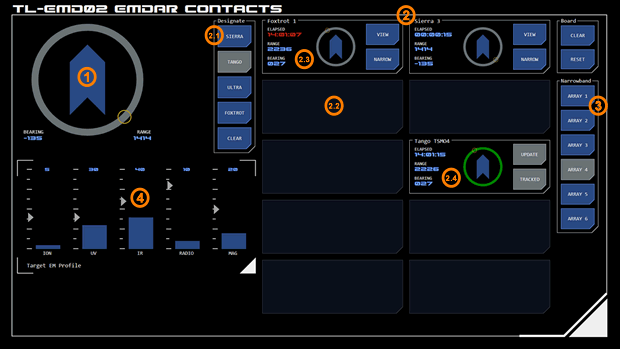

TL-EMD02 Panel
This panel works in conjunction with TL-EMD01. It is dominated by the Contact Board module (in active mode), which allows users to add and manage EMDAR contacts.
1. Contact Orientation
In passive (zero) mode, this Navigation Radial instance provides bearing and range data on either the selected contact, or the selected target on the waterfall display (TL-EMD01).
The colour of the circular track changes to indicate which is currently being displayed:
Grey: indicates that range and bearing to the selected waterfall display target is being displayed.
Purple: indicates the range and bearing to the selected contact (from the contact board) is being displayed.
2. Contact Board
This is an active (zero) mode instance of the Contact Board module. More information on the operation of this module can be found here.
2.1 Designation Buttons
This array of buttons is used to select a designation for a new contact, or a contact being updated.
2.2 Contact Display (empty)
Up to ten contacts can be managed on the board at any one time, indicated by these areas. This is an example of an empty contact - tapping it will create a new contact with the currently displayed range/bearing and designation.
2.3 Contact Display (contact)
This is an example of an active contact.
2.4 Contact Display (tracked)
When a contact is being tracked by an EMDAR narrowband array, the visual range/bearing display's circular track will display as green instead of grey.
3. Narrowband Arrays
Up to six narrowband EMDAR arrays are available to track contacts. Unlike broadband, narrowband arrays are able to track a contact as it chnages position in space. This button array is used to manage the assignment of contacts to narrowband arrays.
4. Target EM Profile
This Linear Monitor instance wil display the current EM ouput of the tracked contact currently being viewed. This data can assist with the identification of a tracked contact. Contacts not currently being tracked by a narrowband array will not generate any data for display in this module.





